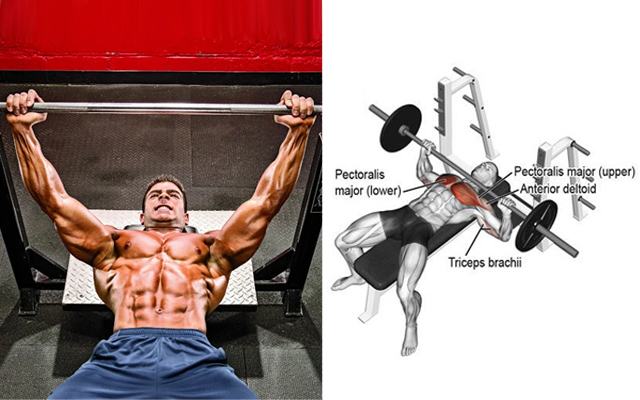Are you tirelessly working out, curling dumbbells day in and day out, but still not seeing the bicep growth you’re striving for? You’re not alone. Many fitness enthusiasts find themselves asking, ‘Why aren’t my biceps getting bigger?’ Despite the sweat and effort, the mirror doesn’t reflect their hard work. If this sounds like you, you’ve come to the right place. This article will delve into the anatomy of the biceps, common training mistakes, effective exercises, and the crucial role of nutrition and rest in muscle growth. Remember, building muscle is a journey that requires consistency, patience, and the right knowledge. So, let’s embark on this journey together and help you achieve those bicep gains you’ve been dreaming of!
Understanding the Anatomy of Biceps

Exploring the anatomy of the biceps muscle is crucial for understanding how it functions and how to effectively target it for growth. Here’s a breakdown of the anatomy of the biceps:
SHOP FOR THE ADJUSTABLE DUMBBELL SET ON AMAZON
- Muscle Composition: The biceps brachii muscle, commonly known as the biceps, is a two-headed muscle located in the front of the upper arm. It consists of two heads: the long head and the short head.
- Long Head: The long head of the biceps originates from the supraglenoid tubercle of the scapula (shoulder blade), specifically within the shoulder joint capsule. It runs along the humerus (upper arm bone) and is responsible for much of the overall mass of the biceps.
- Short Head: The short head of the biceps originates from the coracoid process of the scapula, which is a bony projection at the front of the shoulder blade. It merges with the long head to form the main body of the biceps muscle.
- Tendon Insertion: Both heads of the biceps merge into a single tendon that attaches to the radius bone in the forearm, specifically at a point called the radial tuberosity. This attachment allows the biceps to exert its pulling force on the forearm, facilitating movements such as flexion at the elbow joint.
- Functions: The primary function of the biceps is elbow flexion, which involves bending the arm at the elbow joint to bring the forearm closer to the upper arm. Additionally, the biceps assist in supination of the forearm, which is the movement that rotates the palm from a facing-downward position to a facing-upward position.
- Synergistic Muscles: While the biceps are the primary muscles responsible for elbow flexion and forearm supination, several other muscles assist in these movements. These include the brachialis, which lies underneath the biceps and is a powerful elbow flexor, as well as the brachioradialis and pronator teres, which aid in forearm movement.
Understanding the anatomy of the biceps helps individuals target this muscle effectively during their workouts. By incorporating exercises that emphasize elbow flexion and forearm supination, individuals can stimulate growth and development in the biceps muscle.
Common Mistakes in Bicep Training
When it comes to bicep training, several common mistakes can hinder your progress and potentially lead to injuries. Here are some of them:
- Not Using Full Range of Motion: One of the most common mistakes is not using the full range of motion during exercises. This can limit the development of your biceps as it doesn’t fully engage the muscle.
- Using Too Much Weight: Lifting more weight than you can handle can lead to poor form and potential injuries. It’s better to use a weight that allows you to perform the exercise with proper form.
- Neglecting the Brachialis: The brachialis, the muscle underneath the biceps, is often neglected. However, training this muscle can help increase the overall size of your upper arm.
- Skipping the Eccentric Phase: The eccentric (or lowering) phase of an exercise is just as important as the concentric (or lifting) phase. Neglecting this part of the exercise can limit your muscle growth.
- Not Varying Your Exercises: Doing the same exercises over and over can lead to a plateau. It’s important to vary your exercises to challenge your muscles in different ways.
- Not Resting Enough: Your muscles need time to recover and grow after a workout. Not giving them enough rest can hinder your progress.
SHOP FOR THE RESISTANCE BAND ON AMAZON
Remember, it’s always important to maintain proper form and prioritize safety when training.
Effective Bicep Exercises
Here’s a list of effective bicep exercises along with instructions on how to perform them correctly, including targeted muscles and recommended sets and reps:
Barbell Bicep Curl
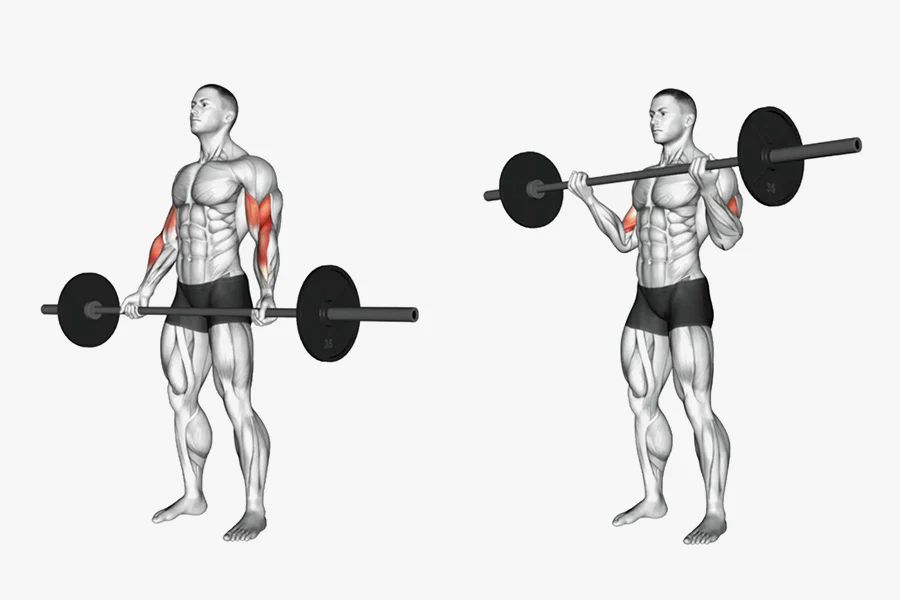
- Targeted Muscles: Biceps brachii, brachialis, brachioradialis.
- How to Perform: Stand with feet shoulder-width apart, grip a barbell with hands shoulder-width apart and palms facing up. Keeping elbows close to your body, curl the barbell upwards towards your chest while contracting your biceps. Slowly lower the barbell back to the starting position.
- Recommended Sets & Reps: 3-4 sets of 8-12 reps.
Dumbbell Bicep Curl
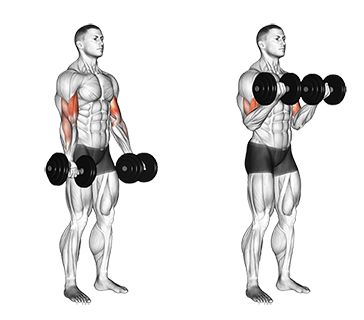
- Targeted Muscles: Biceps brachii, brachialis, brachioradialis.
- How to Perform: Stand with feet shoulder-width apart, hold a dumbbell in each hand with palms facing forward. Keeping elbows close to your body, curl the dumbbells upwards towards your shoulders while contracting your biceps. Slowly lower the dumbbells back to the starting position.
- Recommended Sets & Reps: 3-4 sets of 8-12 reps.
Preacher Curl

- Targeted Muscles: Biceps brachii, brachialis.
- How to Perform: Sit or stand at a preacher curl bench with armpits against the pad. Hold an EZ bar or dumbbells with an underhand grip, allowing arms to fully extend. Curl the weight upwards until forearms are perpendicular to the ground, then lower back down.
- Recommended Sets & Reps: 3-4 sets of 8-12 reps.
Hammer Curl
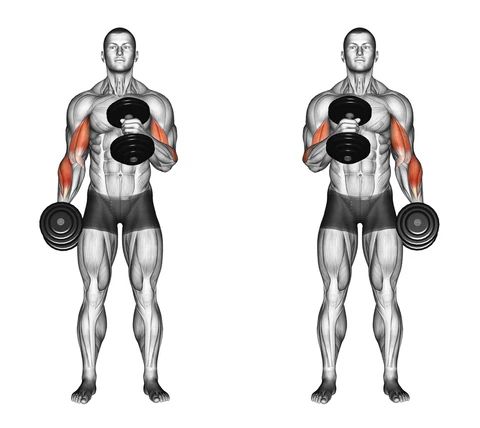
- Targeted Muscles: Brachialis, brachioradialis, biceps brachii.
- How to Perform: Stand with feet shoulder-width apart, hold a dumbbell in each hand with palms facing each other. Keeping elbows close to your body, curl the dumbbells upwards towards your shoulders while maintaining a neutral grip. Slowly lower the dumbbells back to the starting position.
- Recommended Sets & Reps: 3-4 sets of 8-12 reps.
Concentration Curl
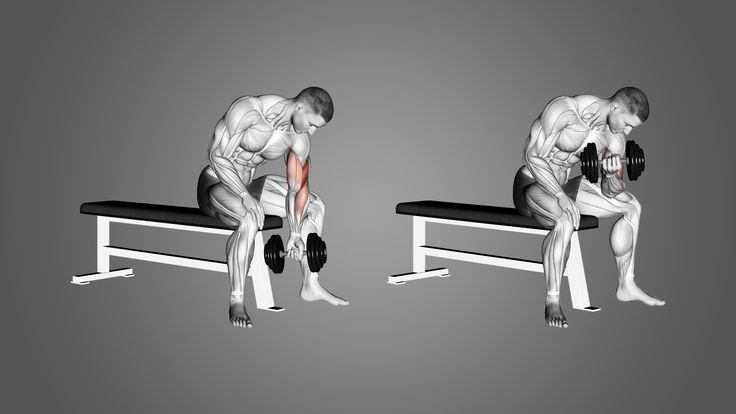
- Targeted Muscles: Biceps brachii, brachialis.
- How to Perform: Sit on a bench with legs spread apart, hold a dumbbell in one hand between your legs with palm facing up. Rest your elbow on the inner thigh of the same side. Curl the dumbbell upwards towards your shoulder while contracting your biceps. Slowly lower the dumbbell back to the starting position.
- Recommended Sets & Reps: 3-4 sets of 8-12 reps per arm.
Incline Dumbbell Curl
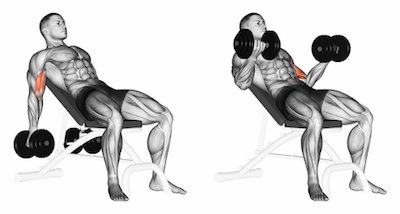
- Targeted Muscles: Biceps brachii, brachialis, brachioradialis.
- How to Perform: Sit on an incline bench set at a 45-degree angle, holding a dumbbell in each hand with arms fully extended and palms facing forward. Curl the dumbbells upwards towards your shoulders while keeping your upper arms stationary and elbows tucked in. Squeeze the biceps at the top of the movement, then slowly lower the dumbbells back to the starting position.
- Recommended Sets & Reps: 3-4 sets of 8-12 reps.
Cable Rope Hammer Curl
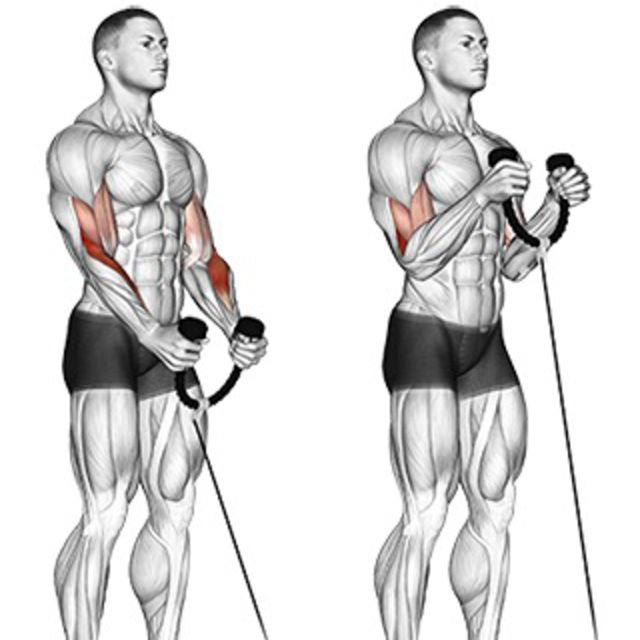
- Targeted Muscles: Brachialis, brachioradialis, biceps brachii.
- How to Perform: Attach a rope attachment to a low pulley cable machine. Stand facing the machine with feet shoulder-width apart, grasp the rope with a neutral grip (palms facing each other). Keep elbows close to your body and curl the rope upwards towards your shoulders, maintaining a neutral grip throughout the movement. Squeeze the biceps at the top of the movement, then slowly lower the rope back to the starting position.
- Recommended Sets & Reps: 3-4 sets of 10-15 reps.
SHOP FOR THE PROTEIN POWDER ON AMAZON
Remember to choose a weight that challenges you within the recommended rep range. Rest for about 60-90 seconds between sets to allow for sufficient recovery. Adjust sets and reps based on your individual fitness goals and preferences. Additionally, always prioritize proper form to avoid injury and maximize effectiveness.
Importance of Nutrition
Nutrition plays a pivotal role in muscle growth and recovery, including your biceps. Here’s why:
Chest Supported Row and Biceps
- Protein for Muscle Repair and Growth: When you work out, you create micro-tears in your muscles. Protein is essential for repairing these tears, leading to muscle growth. It’s recommended to consume a source of protein within an hour after your workout to kickstart the recovery process.
- Carbohydrates for Energy: Carbohydrates are your body’s primary source of energy. They fuel your workouts and help replenish glycogen stores in your muscles post-workout. This is important because glycogen is a form of sugar that can be quickly used for energy.
- Healthy Fats for Hormone Production: Fats play a crucial role in the production of hormones like testosterone, which is important for muscle growth. They also provide a dense source of calories, which can be beneficial if you’re trying to gain muscle mass.
- Vitamins and Minerals for Overall Health: Vitamins and minerals are needed for various bodily functions, including the metabolism of nutrients. For example, Vitamin C helps with the synthesis of collagen, a protein that’s found in muscle tissue.
- Hydration: Staying hydrated is crucial for optimal performance during workouts and for overall health. Water helps transport nutrients to your cells and remove waste products, which is important for muscle recovery.
- Caloric Surplus for Muscle Growth: If you’re looking to increase muscle size, you’ll need to consume more calories than your body burns in a day. This is known as a caloric surplus. However, these should come from nutrient-dense foods to ensure you’re also getting plenty of vitamins and minerals.
SHOP FOR THE FOAM ROLLER ON AMAZON
Remember, everyone’s nutritional needs are different, so it’s important to listen to your body and adjust your diet accordingly.
Rest and Recovery
Rest and recovery are crucial components of any fitness regimen, including bicep training. Here’s why:
- Muscle Repair and Growth: When you exercise, especially during resistance and strength training exercises like weightlifting, microscopic tears occur in the muscle fibers. It’s during rest that your body repairs these tiny tears, a process that helps the muscles to grow (hypertrophy). Without adequate rest, this repair and growth process can be hindered.
- Prevention of Overtraining: Overtraining refers to excessive frequency, volume, or intensity of training, resulting in fatigue and a decrease in performance. It occurs when the body does not have enough time to recover between workouts. Overtraining can lead to a plateau in muscle growth, increased risk of injury, decreased immunity, and hormonal imbalances. It can also lead to psychological effects such as decreased appetite and mood swings.
- Restoration of Energy Stores: Your muscles store glycogen, a form of glucose, which provides energy during workouts. Rest allows these glycogen stores to be replenished, ensuring you have enough energy for your next workout.
- Prevention of Central Nervous System Fatigue: High-intensity workouts can put stress on your central nervous system (CNS). Just like your muscles, your CNS needs time to recover in order to continue coordinating muscle contractions effectively.
Proper Form for Dumbbell Bench Press
Remember, everyone’s body is different, so the amount of rest needed can vary from person to person. It’s always a good idea to listen to your body and take rest days when needed.
FAQs
Q 1. How often should I train my biceps for optimal growth?
Ans. For optimal growth, it’s generally recommended to train your biceps 2-3 times per week. This allows ample time for recovery and growth between workouts. Remember, muscle growth happens during rest, not during the workout itself.
Q 2. Can I train my biceps and triceps on the same day?
Ans. Yes, you can train your biceps and triceps on the same day. This is often done in an “arm day” workout. However, it’s important to ensure you’re not overworking these muscles by also training them heavily on other days of the week.
Q 3. What are some signs of overtraining?
Ans. Signs of overtraining can include persistent muscle soreness, decreased performance, increased susceptibility to injuries, sleep disturbances, decreased immunity, loss of appetite, and mood changes.
Q 4. How can I measure my bicep progress?
Ans. You can measure your bicep progress in several ways. This can include tracking the increase in weight or reps over time, measuring the circumference of your biceps with a tape measure, or taking progress photos.
Q 5. What should I eat before and after a bicep workout?
Ans. Before a workout, it’s good to have a balanced meal with protein, carbs, and fats to fuel your workout. After a workout, it’s important to consume protein to aid in muscle recovery and growth, and carbohydrates to replenish glycogen stores.
Q 6. Can I still train my biceps if I have an injury?
Ans. If you have an injury, it’s important to consult with a healthcare professional before continuing your workouts. They can provide guidance on what exercises, if any, are safe to perform.
Q 7. What are some modifications for bicep exercises if they’re too difficult?
Ans. If a bicep exercise is too difficult, you can try reducing the weight, decreasing the range of motion, or performing the exercise in a seated position for more stability. Always prioritize form over weight to prevent injury.
Conclusion
In conclusion, building bigger biceps is not just about lifting weights. It’s a comprehensive process that involves understanding the anatomy of your biceps, performing exercises correctly, avoiding common training mistakes, and prioritizing nutrition and rest. Remember, everyone’s body is different, and what works for one person may not work for another.
It’s always best to consult with a fitness professional before starting any new workout regimen. With patience, consistency, and the right approach, you’ll be on your way to achieving those bicep gains you’ve been dreaming of.

Good day, and welcome to Fitthour. My name is Shubham Vijay, and I am a certified personal trainer and nutrition coach with 6 years of experience in the fitness industry. At Fitthour, we specialize in types of training, such as strength training, cardio, or HIIT, and our mission is to help clients achieve their fitness goals and improve their overall health.


